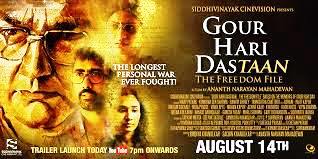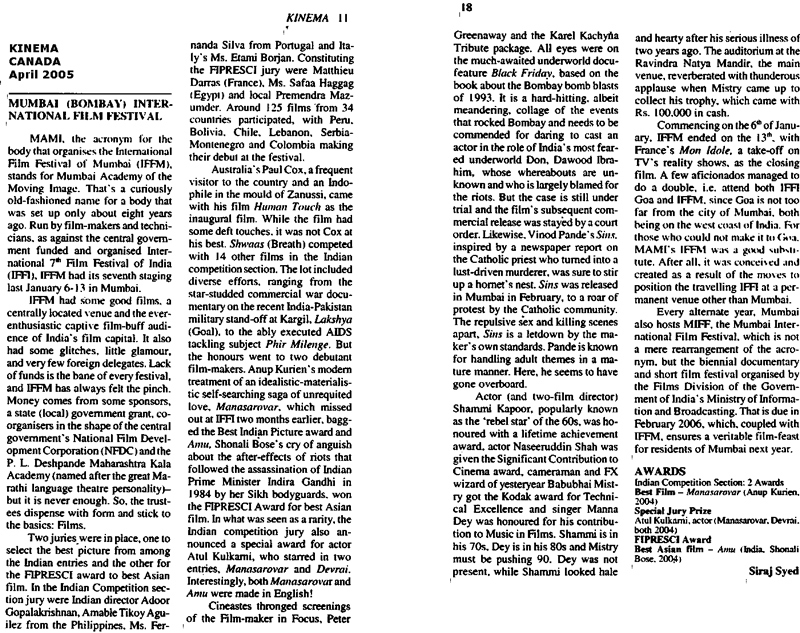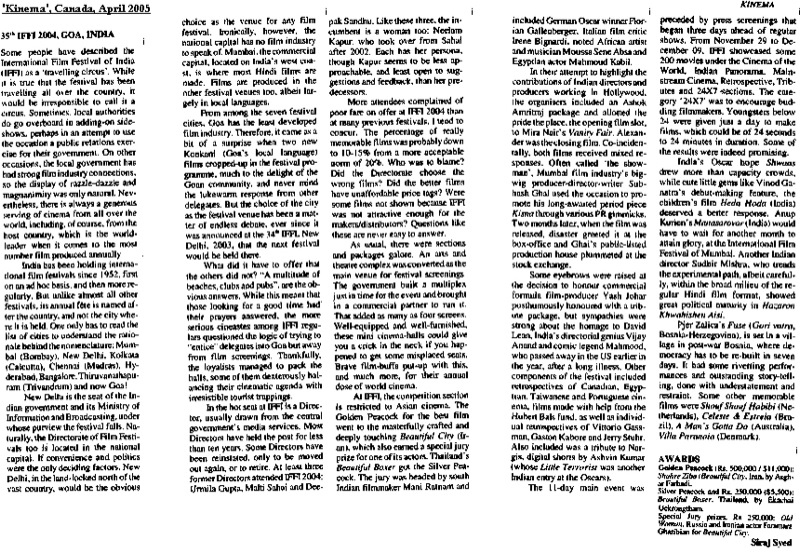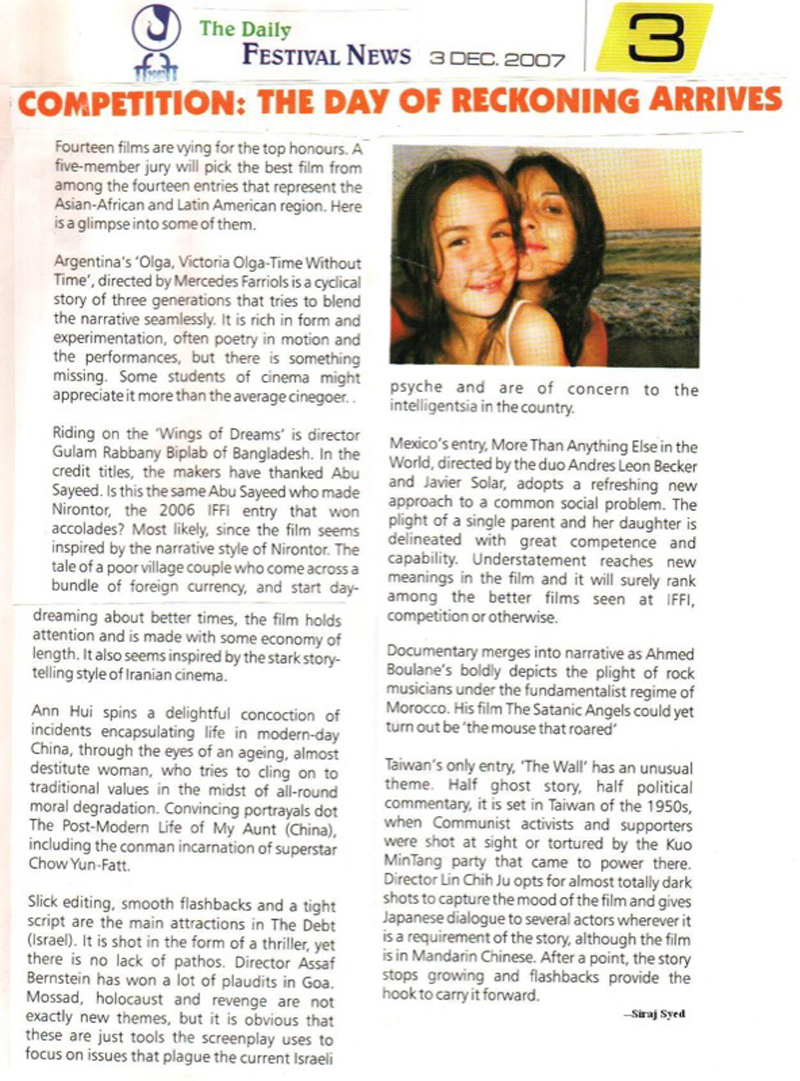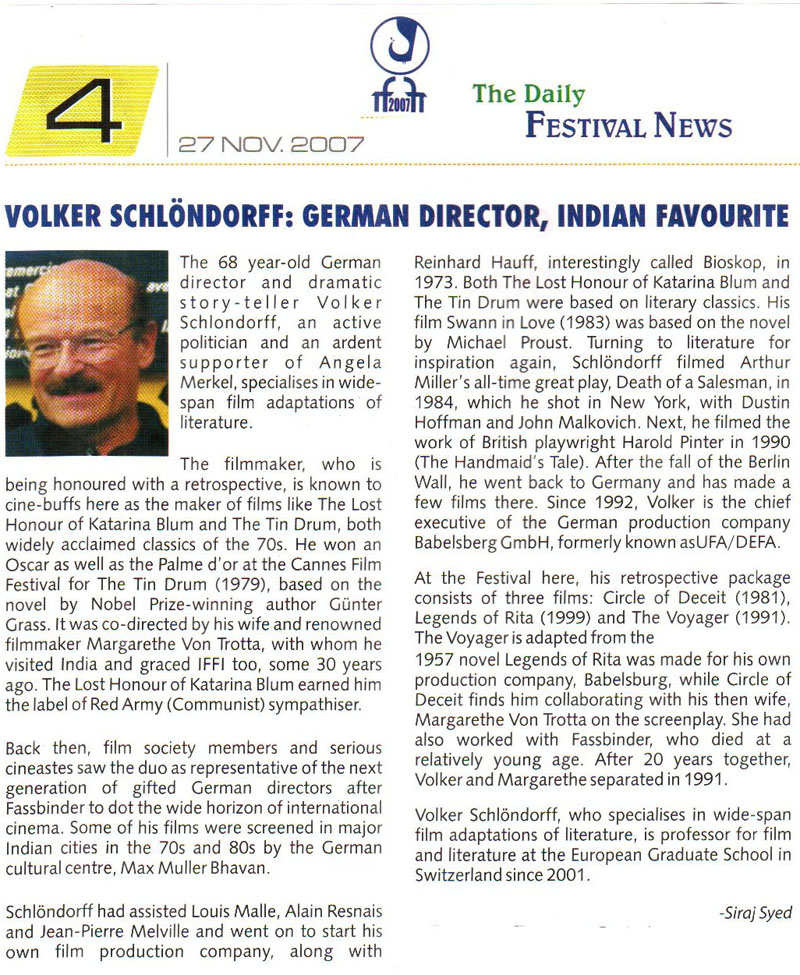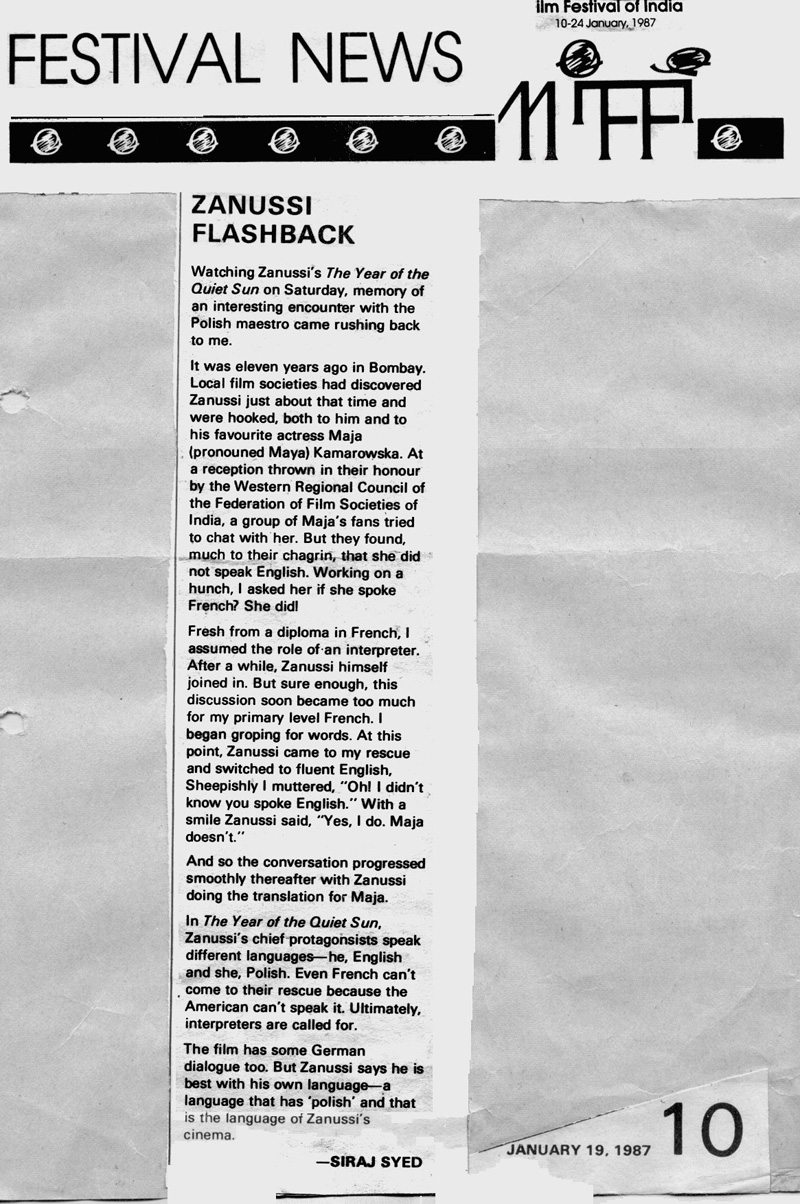|
|
||
|
Pro Tools
FILMFESTIVALS | 24/7 world wide coverageWelcome ! Enjoy the best of both worlds: Film & Festival News, exploring the best of the film festivals community. Launched in 1995, relentlessly connecting films to festivals, documenting and promoting festivals worldwide. Working on an upgrade soon. For collaboration, editorial contributions, or publicity, please send us an email here. User login |
Gour Hari Dastaan/The Freedom File, Review: His-story
Gour Hari Dastaan/The Freedom File, Review: His-story Described in the press as a Kafkaesque black comedy when it was launched in 2011, Gour Hari Dastaan is based on a true story, of Gour Hari Das (now 85), with some Kafkaesque undertones, but very little or no black comedy. It cannot afford to be a comedy, let alone a black one, since it deals with the sensitive subject of the neglect and disregard suffered by those who participated in the struggle to rid India of British colonial rule. British rule over India lasted for over 150 years, till Independence was attained, in 1947. Naturally, very few of the freedom fighters are alive in the new millennium. Some heroes, who threw bombs or killed British officials and/ or were martyred, are revered as the pillars of freedom, while the over-whelming majority of the task-force has to be content with a plaque, government grants and some social privileges for them and their families. Fact is that, in a country with extremely high levels of corruption and tons of red-tape at every corner, even getting recognition is an uphill task. Director Ananth Narayan Mahadevan’s screen adaptation of one such man’s predicament is laudable in its noblesse, tugs the heart, and yet its execution falls just short of capturing the imagination of a 2015 audience. Gour Hari Das (Vinay Pathak), a freedom fighter who works in the Indian central government run Khadi (indigenous, hand-woven cloth, that Gandhijee used to weave) and Village Industries Commission, leads, a quiet, uneventful life, along with his wife and son, One day, his son, Anil, is unable to secure college admission due to a low percentage score at the qualifying examination, but is told that if his father had been a freedom fighter, he could have made it through the government quota for such children. His father gives him a jail release receipt, but the college rejects it, on the grounds that mere incarceration cannot be proof of freedom fighting, as even common criminals and murderers serve jail terms. Das, deeply wounded at the slight, is jolted to learn that he would need a Taamra Patra (engraved copper plaque) to substantiate his claim. Determined to get his due, he launches a struggle against red-tape, bureaucracy, apathy and callous disregard for those who suffered imprisonment, torture and several other kinds of trauma at the hands of the British. In the quest for this certificate to prove his credentials, he begins a journey that sucks up almost his entire life. His wife Lakshmi (Konkona Sen Sharma) stands solidly behind his crusade, while tabloid journalists Rajeev Singhal (Ranvir Shorey) and Anita (Tannishtha Chatterjee) join the cause. It turns out be a long, taxing ordeal, spanning over three decades, but Das carries on relentlessly. Using the name of the protagonist, a person who is unknown to even students of Indian history, as the title of the film, was fraught with the danger of alienation. Adding the suffix taan to Gour Hari Das-taan makes the title read, ‘The Tale of Gour Hari’, dastaan being Urdu for tale, and makes it slightly more palatable. Still, there is still no attraction in the name. Maybe that is the point. The film is about an unsung hero, so, the makers felt, it could do with a bland title. Not very clever marketing, to be sure. Even in the film, in one scene, fed-up of having to introduce himself time and again, and still failing to make an impact, Gour Hari Das announces himself as Mohandas Karamchand Gandhi! The real-life Gour was a key member of the 50-strong local Vanar (Banar) Sena (monkey army), and ran across bridges, rail tracks and dangerous terrain, to deliver covert messages, often in pitch darkness. Once, he had to wait for trains to approach the crossing and shed some light (opening sequence in the film), and covered the distance is stages, with the help of 6-7 passing trains. He was jailed for 56 days (the term varies alarmingly in various press accounts and even in the film itself, partly due to the inclusion or exclusion of judicial custody while computing the total imprisonment) just for flying the Indian tricolour flag. After independence, Gour left everything to work at Gandhijee’s Wardha Ashram, from 1950 to 1955. He was helped in his Taamra Patra cause by a neighbour, called Rajeev Singhal, and activist Mohan Krishnan, of the NGO National Anti Corruption and Crime Preventive Council (founded 1995). Both are represented in the film, Rajeev as a muddled-up journalist, later Das’s neighbour, and Mohan Krishnan, a principled lawyer. In the script, Gour’s village is Balasore, Odisha, while in a recent interview, he identified it as Jalasore. Screenplay is credited to Mahadevan and C.P. Surendran, while there is no separate credit for dialogue. Surendran, till recently the Editor-in-Chief at the Mumbai daily newspaper DNA, has worked with The Times of India, Times Sunday Review and Bombay Times. A well-known name in poetry circles, he is also known as the ‘misogynist columnist’, on account of his strong views against feminism. These views find ready expression in the character of Rajeev. A merger of two real-life characters from Gour’s life, he is handicapped by a stereo-type image, the women-bashing touch notwithstanding: Career-issues, scraps with his ambitious boss who was once his colleague, unhappy marriage, alcoholism, a sympathetic female colleague…the works. In fact, no character in the film is given any real depth, and the appearances on screen are strictly utilitarian. Gour’s life unfolds as chapters, each of which is episodic, almost like a TV serial. Dialogue is pithy in many places, one flat line conveying many highs and lows in the narrative curve. One does wonder whether Mahadevan and Surendran wrote these lines, in Hindi, themselves. Scribe-turned-stage actor-turned TV and film actor-turned TV and film director, Ananth Narayan Mahadevan, who added the middle name only much later in his career, had a long stint under actor-director Dinesh Thakur in his theatre group, Ank, an experience that helped this Tamil-speaking actor develop his Hindi-Urdu vocabulary and dialogue delivery. My first look at his directorial skills was in a film called Mee Sindhutai Sapkal, made in the Marathi language. Ananth, along with Sanjay Pawar, received the National Award for Best Screenplay and Dialogue, for their efforts. It bagged a total of four National Awards in 2010. Mahadevan debuted with the film Dil Vil Pyar Vyar (2002) and has made a host of films since. Mee Sindhutai Sapkal was biopic, and its success prompted its producers to put their faith in Ananth’s next, also a biopic, but this time in Hindi. Sindhutai’s screen persona was that of a feisty woman in a contemporary conflict, while Gour’s life is lost in dusty cup-boards dating back to the 1940s, and he comes across as a dull, uninteresting person, which he might presently be, and might have been, even in his younger days, but a film-maker needs to overcome this cinematic hurdle. Mahadevan’s shot-taking fails to address this obstacle, and is reflective of the Gour era. Around the mid-way point, even Alphonse Ray’s shot-on-film visuals cannot prevent a 40-wink interlude. Like in Mee Sindhutai Sapkal, he uses a smart pre-title beginning, but forgets to get back to the significance of the boy running along the railway tracks. At the Balasore jail, Rajeev asks a 60 looking jailor, “Is your grand-father alive?” The scene, in which Gour is asked by a security guard to spin a shirt from cotton seeds that he has brought along, needed to be better shaped to be credible, as did the Mohandas Karamchand Gandhi scene. An ensemble cast is assembled only to deliver cameos, usually adding one phrase in Marathi to remind you that the locale is Mumbai. To his credit, Mahadevan recreates the ambience of the each locale very effectively. Gour’s first realisation of memory loss is a fine piece of cinema. His meeting with Gandhi is well-framed and well-shot. Orissa (now Odisha) missing from the large cut-out map of India, only to be found stuck and folded behind, is another take-away. If, after seeing the film, you feel that the story has shades of Saaraansh, and Vinay Pathak reminds you of the Saaraansh lead actor Anupam Kher, whose on-screen plight was not too different from that of Gour’s, and who was about the same real age, playing an old man, as Pathak was when this film was made, you will be readily forgiven. The way the Taamra Patra issue is resolved, you might end up feeling that there was much ado about nothing. Vinay Pathak (Khosla Ka Ghosla, Johnny Gaddar, My Name is Khan, Bheja Fry) looks and underplays the part. His use of ‘hum’ as a personal collective/royal pronoun ‘we’, is unconvincing, as his is his accent, in general. For the large part, he remains dead-pan. This helps some crisp one-liners create impact. For the rest, it tends to get monotonous. Konkona Sen Sharma (Mr. and Mrs. Iyer, Page 3, Omkara, Life in a... Metro) returns to the screen after child-birth, and gets extra-casual. Gifted with an easy-going style, casualness comes to her effortlessly. It is not called for in this film, though. Two scenes are apparently written to bring out the fire in her; both come across as contrived. Her real-life husband Ranvir Shorey (Ek Chhotisi Love Story, Traffic Signal, Bajatey Raho), has metamorphosed into a much better actor than the one we encountered at the Traffic Signal. Tannishtha Chatterjee (Jal, Gulab Gang, Bhopal: A Prayer for Rain) raises expectations, only to just pass muster. Others who feature in one or two scene roles are Vikram Gokhale (Chief Minister), Vipin Sharma (Ahirkar, the crooked neighbour), Rajit Kapoor (Mohan Joshi, Mohan Krishna of the real world), Saurabh Shukla (Special Secretary - Freedom Cell), Asrani (Khadi Commission boss), Siddharth Jadhav (pension tout), Mohan Kapoor (doctor) and Murli Sharma (official), Viju Khote (grocer Yadav), Neha Pendse (Das's daughter-in-law), Khushboo (Rajiv Singhal's wife), Neena Kulkarni (Mrs. Apte--Freedom Cell), Rahul Vohra (editor of Mid-Day) and Bharat Dabholkar (security guard). Music by Dr. L. Subramaniam (not commonly associated with Hindi cinema scores), and songs in the voice of his wife and popular crooner Kavitha Krishnamurthy, are serene and dignified. Sound design by Resul Pookutty is of a high calibre, while editor Sreekar Prasad sticks to blank looks as most of his cutting points. Worth a watch, but go prepared. Rating: **1/2 Trailer: https://www.youtube.com/watch?v=OqpHsT41CM4 13.08.2015 | Siraj Syed's blog Cat. : Ananth Narayan Mahadevan Asrani Balasore British C.P. Surendran colonial freedom struggle gandhi Gour Hari Das INDEPENDENCE india Jalasore Kavitha Krishnamurthy Konkona Sen Sharma L. Subramaniam Neena Kulkarni Odisha Orissa Rajit Kapoor Ranvir Shorey Resul Pookutty Saurabh Shukla Sreekar Prasad Tannishtha Chatterjee Vanar Sena Vikram Gokhale Vinay Pathak Independent
|
LinksThe Bulletin Board > The Bulletin Board Blog Following News Interview with IFTA Chairman (AFM)
Interview with Cannes Marche du Film Director
Filmfestivals.com dailies live coverage from > Live from India
Useful links for the indies: > Big files transfer
+ SUBSCRIBE to the weekly Newsletter Deals+ Special offers and discounts from filmfestivals.com Selected fun offers
> Bonus Casino
User imagesAbout Siraj Syed Syed Siraj Syed Siraj (Siraj Associates) Siraj Syed is a film-critic since 1970 and a Former President of the Freelance Film Journalists' Combine of India.He is the India Correspondent of FilmFestivals.com and a member of FIPRESCI, the international Federation of Film Critics, Munich, GermanySiraj Syed has contributed over 1,015 articles on cinema, international film festivals, conventions, exhibitions, etc., most recently, at IFFI (Goa), MIFF (Mumbai), MFF/MAMI (Mumbai) and CommunicAsia (Singapore). He often edits film festival daily bulletins.He is also an actor and a dubbing artiste. Further, he has been teaching media, acting and dubbing at over 30 institutes in India and Singapore, since 1984.View my profile Send me a message The EditorUser contributions |

















